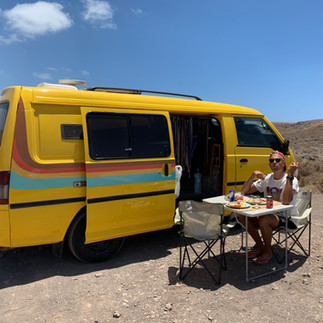Lanzarote: 5 days itinerary in van
- Vanessa Valenti

- 18 gen 2022
- Tempo di lettura: 9 min
Aggiornamento: 13 mag 2023
Here is our 5-day itinerary in Lanzarote, an island belonging to the Canary archipelago. Below is the schedule day by day: consider that we had been on the road for 10 days (click here for the post), we left Porto and crossed all of Portugal to Seville, where we flight to Lanzarote. A little tired, we decided to enjoy these days on the island calmly, recovering some energy, taking advantage of the freedom given to us by our Banana Camper and improvising a lot, even following the day-to-day weather conditions.

Tuesday 07.06.21
Flight from Seville SVQ - ACE Took the Banna Camper (our yellow van) Refueling and spent the night in a van in Las Ancones
Wensday 07.07.21
Jardin de Cactus *
Jameos del Agua *
Cuevas de los Vierdes *
Pranzo a Playa de Famara
Playa Dorada
Dinner at Lomo Alto (Puerto del Carmen)
Night in van in Playa del Janubio
Thursday 07.08.21
Playa de Janubio
Salinas de Janubio
El Golfo
Charcos de los Clicos
Playa Montana Bermeja
Playa de Las Mujeres
Night in Playa del Janubio
Friday 07.09.21
Montana del Fuego * - Parque Natural Timanfaya
Playa de Papagayo
El Charcon, Arrecife: localini e ristorantini carini, vivaci
Night in Playa Blanca
Saturday 07.010.21
Mirador del Rio*
Playa Dorada
El Charcon
Dinner at Restaurant ESTRELLA
Sunday 07.11.21
Banana Camper delivery
Flight back home ACE - BLQ

Lanzarote is an island belonging to the archipelago of the Canary Islands, a Spanish territory located alongside the African coast, in the Atlantic Ocean. It is the most north-eastern of the islands and thanks to its geographical position it enjoys a warm climate all year round, with mild winters and hot, sunny summers. The annual average is 21 ° C. The island is particularly exposed to trade winds, winds that blow all year round, especially in the afternoon, creating waves that are particularly popular with surfers, making it ideal if you are a fan. Honestly, I expected a similar temperature in Tenerife (another island in the Canary archipelago), where we had been a couple of months earlier. The landscape and the climate that you will find in Lanzarote, on the other hand, is totally different: both are volcanic islands but Tenerife is still green and not very windy. Lanzarote, on the other hand, is completely desert and the wind is constant, intense and honestly I have often found it particularly annoying. In the five days we were there it was always so windy, 24 hours a day, we never had a moment's respite. After the first few days we began to know the weather and to move to the areas towards the south that are generally less windy and always sunny. In the north, however, it is increasingly windy and covered.
CACT Lanzarote* - turismolanzarote.com
The Art, Culture and Tourism Centers of Lanzarote are the main attractions of the island and some are really worth a visit. This is the list of the various centers with the various single prices alongside:
Jardìn de Cactus (6,5€)
Jameos del Agua (10€)
Cuevas de los Verdes (10€) - guided tour 45min
Montañas del Fuego - Parque Natural Timanfaya (12€)
Mirador del Rìo (5€)
MIAC - Castillo de San José (4€)
Moumento al Campesino (gratuito)
On your first visit to one of the centers I recommend that you buy one of the following packages in order to save a little: there are various options, choose the one that suits you best based on the duration of your trip and your interests. We chose the one from six centers, which is perhaps the most convenient if you intend to do them all. We only managed to do the first 4, we went to Mirador del Rìo but the sky was very overcast and the clouds were very low, so we couldn't see anything. We still managed to save even by doing only those 4.
Packages:
3 centers voucher to choose from among the various options: € 23.5
4 centers voucher to choose from among the various options: 29 €
6 centers voucher: 35 €

Jardìn de Cactus
The Cactus Garden is located north of the island, in an old quarry. The artist César Manrique converted the space into an area divided into terraces where over 1400 species of cacti are grown, all classified. The garden is surmounted by a windmill formerly used in the grinding of corn and now functioning for educational purposes. Overall the garden is very nice and here you'll find every variety, of all colors and sizes. It is a nice experience, an excellent idea especially on cloudy days.

Jameos del Agua
The Jameos del Agua is a natural space and artistic, cultural and tourist center designed by César Manrique. It's located north of Lanzarote, and the name jameo is of aboriginal origin and refers to a hole that is produced due to the collapse of the roof of a lava tunnel. It's located inside a 6km volcanic tunnel produced by the eruption of the Corona volcano. From the entrance you will climb a stone staircase to the first cave, the Jameo Chico, transformed by Manrique into a bar / restaurant overlooking a small lake with extremely transparent water - regulated by the Atlantic Ocean - and home to blind crabs, which have now become the symbol of the Jameos del Agua. Crossing the lake on a narrow path, you come to Jameo Grande, a huge outdoor cave lined with tropical plants and a crystal clear and turquoise pool (it cannot be used, only the King of Spain is allowed to swim here). From the opposite end of the Jameo Grande you can then access the Auditorium, which was built in part in the lava tunnel that descends towards the ocean. What can I say, the spaces are certainly extravagant and interesting, perhaps a little too crowded, it didn't frankly drive us crazy, nothing special. We went there on a cloudy day, so we took the opportunity to visit all the cultural centers.
Cuevas de los Verdes

Located in the north of the island near the previous centers described, it's certainly the one we appreciated the most, the one that, if you have to choose one, you absolutely cannot miss. Cueva de los Verdes is a cave with a mythological aspect, full of legends that is part of a volcanic tunnel that was created during a prehistoric eruption of the Monte de La Corona volcano more than 4000 years ago. A large lava flow rushed towards the east coast until it reached the sea: it's the largest volcanic tunnel in the world. Many think that the name of Cueva de los Verdes is due to the prevailing color of the mosses that have grown on the walls but in reality it derives from the family of shepherds who inhabited these lands. The visit to the caves is guided only given the uniqueness of the spaces and the somewhat inaccessible path in some places: you will be divided into small groups and then led by the guide who will explain the various spaces to you in English and Spanish. All this takes about 45 minutes on a route of about 6km but I warn you: it's not the right place for those suffering from claustrophobia; inside it is very narrow, dark and humid.
Montañas del Fuego - Parque Natural Timanfaya

In the heart of the Parque Natural Timanfaya you'll find the Montañas del Fuego, originating from a volcanic eruption between 1730-1736, amidst lunar landscapes in the immense desert expanses of lava. You can only explore them by car or bus, on a beaten track, which does not allow detours. At the top you will find the cultural center and the El Diablo restaurant, also built by César Manrique, where the specialty is grilled meat, cooked on a jet of natural boiling air from the volcano below. The view is spectacular, and the landscapes are definitely breathtaking, but honestly we are left a little disappointed by the ban on trekking and in any case to go off the beaten track by car.
Beaches in Lanzarote
Playa de Las Mujeres and Playa de Papagayo

Definitely the two most beautiful beaches we have found on the island: fine golden sand, crystal clear turquoise water, calm sea ... I would also like to tell you little windy but I would lie: even here the wind blew relentlessly without interruption. But if you stay near the rocks you will be a little more sheltered. They are located a few kilometers from the famous Playa Blanca resort and within the Los Ajaches Natural Park, a protected area consisting of beautiful beaches and coves, also known as the Papagayo beaches. The park is accessed by car and you will have to pay a 3 € ticket to reach the various beaches along a few kilometers of dirt road. The only refreshment point on the beaches of Los Ajaches is at Papagayo Beach, on the right, at not exactly cheap prices. Luckily we had our trusty Banana Camper so we had lunch in the large parking lots that you will find at each cove.

Playa de Famara
Located in the north of Lanzarote, it's one of the most popular beaches on the island. The beach consists mainly of stones and sand and stretches for 5km, therefore it is by far not only the longest beach in Lanzarote but also one of the most popular for wave lovers, thanks to the strong continuous wind.

Playa Dorada
It's an artificial beach near Playa Blanca, definitely the least windy on the island, here we really enjoyed a bit of the sea in peace. Given its location it's always very crowded, but still beautiful, with soft golden sand and crystal clear water that is always very calm, with a splendid view over Fuerteventura. Here you will find a part of the free beach and a part equipped with many chiringuiti and restaurants where you can refresh yourself. It's not so easy to find parking as it's a very busy area but with a little insistence you should do it.
Playa del Caletòn Blanco
The name is perfect for the sand that is characteristic of the place, white and clean like few others. A natural pool of crystal clear water occupies a large part of this tropical paradise dotted with volcanic lava. To enjoy swimming to the fullest, it's preferable to go there at high tide.
Playa Montana Bermeja

Near the village of El Golfo lies the black beach of Playa de la Montaña Bermeja, which is 400m long. If you travel along the road, usually to get to El Charco, this beach is worth a short stop. The waves are strong and there is a treacherous current, making it very dangerous, but the black sand is very special. It owes its name to the Montaña Bermeja that lies behind it, and its reddish colors in all their splendor, which together with the water basin offer impressive photographic scenarios.
Playa de Janubio and Salinas de Janubio

Near the village of Yazia extends for 1km the black sand beach of Playa de Janubio characterized by dark sand and black lava stone. It's not recommended to bathe in the current sources, but the spectacle is fantastic, with the cliffs and anthracite-colored stones that contrast with the blue ocean and the red-brown mountains in the background.

Directly behind Playa de Janubio, in the Laguna de Janubio, you can admire the typical salt marshes of Lanzarote, the Salinas de Janubio. Used for the extraction of salt, they offer a splendid elevated panoramic view of the square basins of the Saline di Janubio, the largest salt extraction plant in the Canaries. The visit to the salt pans is only with a guide and for a fee, but I recommend that you go all the way to the entrance where you will find an artisan shop where you can buy all the typical salt and other natural products of the island.

Charco de los Clicos

Lago Verde is also known as Charco de los Clicos or Playa El Golfo. It's a green lake formed in the crater of an ancient volcano, which owes its color to a type of algae that grows inside. After the eruptions of 1730, the volcano's crater flooded, thus forming the famous green lagoon. It can only be visited from afar, being a nature reserve it's not allowed to approach it, which makes the visit a bit disappointing: from the parking lot there is a dirt path that leads to the viewpoint, from where you can admire the lake and take the best photos.

La Graciosa
We weren't able to go, but it was among the places I had marked for our trip, and it deserves a mention. La Graciosa is a small island located northwest of Lanzarote, considered a natural wonder and often a day trip destination for tourists staying in Lanzarote. It can be reached by sea with the ferries that depart from the port of Orzola at different times of the day: the ticket office is located at the port but it is possible to book in advance online (here the link). In La Graciosa you can go on boat excursions, scuba diving (being a protected area and located in the middle of the Marine Reserve of the Chinijo Archipelago), enjoy its pristine beaches with sands white or golden and turquoise and crystal clear waters, go surfing or enjoy a meal of fresh fish in Caleta de Sebo.
Here we are at the end of this mini-guide for your trip to Lanzarote. Have you ever been there? Let me know what you think!

















